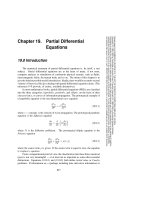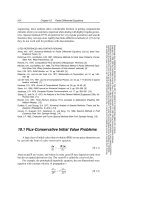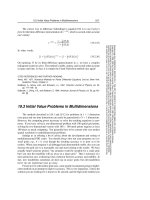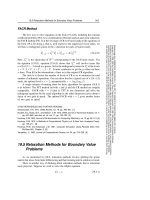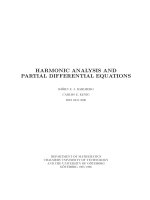Introduction to Partial Differential Equations: A Computational ApproachAslak Tveito Ragnar potx
Bạn đang xem bản rút gọn của tài liệu. Xem và tải ngay bản đầy đủ của tài liệu tại đây (1.95 MB, 402 trang )
Introduction to Partial
Differential Equations:
A Computational
Approach
Aslak Tveito
Ragnar Winther
SpringerPreface
“It is impossible to exaggerate the extent to which modern
applied mathematics has been shaped and fueled by the gen-
eral availability of fast computers with large memories. Their
impact on mathematics, both applied and pure, is comparable
to the role of the telescopes in astronomy and microscopes in
biology.”
— Peter Lax, Siam Rev. Vol. 31 No. 4
Congratulations! You have chosen to study partial differential equations.
That decision is a wise one; the laws of nature are written in the language
of partial differential equations. Therefore, these equations arise as models
in virtually all branches of science and technology. Our goal in this book
is to help you to understand what this vast subject is about. The book is
an introduction to the field. We assume only that you are familiar with ba-
sic calculus and elementary linear algebra. Some experience with ordinary
differential equations would also be an advantage.
Introductory courses in partial differential equations are given all over
the world in various forms. The traditional approach to the subject is to
introduce a number of analytical techniques, enabling the student to de-
rive exact solutions of some simplified problems. Students who learn about
viii Preface
computational techniques on other courses subsequently realize the scope
of partial differential equations beyond paper and pencil.
Our approach is different. We introduce analytical and computational
techniques in the same book and thus in the same course. The main reason
for doing this is that the computer, developed to assist scientists in solv-
ing partial differential equations, has become commonly available and is
currently used in all practical applications of partial differential equations.
Therefore, a modern introduction to this topic must focus on methods suit-
able for computers. But these methods often rely on deep analytical insight
into the equations. We must therefore take great care not to throw away
basic analytical methods but seek a sound balance between analytical and
computational techniques.
One advantage of introducing computational techniques is that nonlinear
problems can be given more attention than is common in a purely analytical
introduction. We have included several examples of nonlinear equations in
addition to the standard linear models which are present in any introduc-
tory text. In particular we have included a discussion of reaction-diffusion
equations. The reason for this is their widespread application as important
models in various scientific applications.
Our aim is not to discuss the merits of different numerical techniques.
There are a huge number of papers in scientific journals comparing different
methods to solve various problems. We do not want to include such discus-
sions. Our aim is to demonstrate that computational techniques are simple
to use and often give very nice results, not to show that even better results
can be obtained if slightly different methods are used. We touch briefly
upon some such discussion, but not in any major way, since this really be-
longs to the field of numerical analysis and should be taught in separate
courses. Having said this, we always try to use the simplest possible nu-
merical techniques. This should in no way be interpreted as an attempt to
advocate certain methods as opposed to others; they are merely chosen for
their simplicity.
Simplicity is also our reason for choosing to present exclusively finite
difference techniques. The entire text could just as well be based on finite
element techniques, which definitely have greater potential from an appli-
cation point of view but are slightly harder to understand than their finite
difference counterparts.
We have attempted to present the material at an easy pace, explaining
carefully both the ideas and details of the derivations. This is particularly
the case in the first chapters but subsequently less details are included and
some steps are left for the reader to fill in. There are a lot of exercises
included, ranging from the straightforward to more challenging ones. Some
of them include a bit of implementation and some experiments to be done
on the computer. We strongly encourage students not to skip these parts.
In addition there are some “projects.” These are either included to refresh
Preface ix
the student’s memory of results needed in this course, or to extend the
theories developed in the present text.
Given the fact that we introduce both numerical and analytical tools, we
have chosen to put little emphasis on modeling. Certainly, the derivation
of models based on partial differential equations is an important topic, but
it is also very large and can therefore not be covered in detail here.
The first seven chapters of this book contain an elementary course in
partial differential equations. Topics like separation of variables, energy ar-
guments, maximum principles, and finite difference methods are discussed
for the three basic linear partial differential equations, i.e. the heat equa-
tion, the wave equation, and Poisson’s equation. In Chapters 8–10 more
theoretical questions related to separation of variables and convergence of
Fourier series are discussed. The purpose of Chapter 11 is to introduce
nonlinear partial differential equations. In particular, we want to illustrate
how easily finite difference methods adopt to such problems, even if these
equations may be hard to handle by an analytical approach. In Chapter 12
we give a brief introduction to the Fourier transform and its application to
partial differential equations.
Some of the exercises in this text are small computer projects involving
a bit of programming. This programming could be done in any language.
In order to get started with these projects, you may find it useful to pick
up some examples from our web site, http://www.ifi.uio.no/˜pde/, where
you will find some Matlab code and some simple Java applets.
Acknowledgments
It is a great pleasure for us to thank our friends and colleagues for a lot of
help and for numerous discussions throughout this project. In particular,
we would like to thank Bent Birkeland and Tom Lyche, who both partici-
pated in the development of the basic ideas underpinning this book. Also
we would like to thank Are Magnus Bruaset, Helge Holden, Kenneth Hvis-
tendahl Karlsen, Jan Olav Langseth, Hans Petter Langtangen, Glenn Terje
Lines, Knut Mørken, Bjørn Fredrik Nielsen, Gunnar Olsen, Klas Samuels-
son, Achim Schroll, Wen Shen, Jan Søreng, and
˚
Asmund Ødeg˚ard for read-
ing parts of the manuscript. Finally, we would like to thank Hans Birkeland,
Truls Flatberg, Roger Hansen, Thomas Skjønhaug, and Fredrik Tyvand for
doing an excellent job in typesetting most of this book.
Oslo, Norway, April 1998.
Aslak Tveito
Ragnar Winther
Contents
1 Setting the Scene 1
1.1 What Is a Differential Equation? 1
1.1.1 Concepts 2
1.2 The Solution and Its Properties 4
1.2.1 An Ordinary Differential Equation 4
1.3 A Numerical Method 6
1.4 Cauchy Problems 10
1.4.1 First-Order Homogeneous Equations 10
1.4.2 First-Order Nonhomogeneous Equations 13
1.4.3 The Wave Equation 15
1.4.4 The Heat Equation 18
1.5 Exercises 20
1.6 Projects 28
2 Two-Point Boundary Value Problems 39
2.1 Poisson’s Equation in One Dimension 40
2.1.1 Green’s Function 42
2.1.2 Smoothness of the Solution 43
2.1.3 A Maximum Principle 44
2.2 A Finite Difference Approximation 45
2.2.1 Taylor Series 46
2.2.2 A System of Algebraic Equations 47
2.2.3 Gaussian Elimination for Tridiagonal Linear Systems 50
2.2.4 Diagonal Dominant Matrices 53
xii Contents
2.2.5 Positive Definite Matrices 55
2.3 Continuous and Discrete Solutions 57
2.3.1 Difference and Differential Equations 57
2.3.2 Symmetry 58
2.3.3 Uniqueness 61
2.3.4 A Maximum Principle for the Discrete Problem . . . 61
2.3.5 Convergence of the Discrete Solutions 63
2.4 Eigenvalue Problems 65
2.4.1 The Continuous Eigenvalue Problem 65
2.4.2 The Discrete Eigenvalue Problem 68
2.5 Exercises 72
2.6 Projects 82
3 The Heat Equation 87
3.1 A Brief Overview 88
3.2 Separation of Variables 90
3.3 The Principle of Superposition 92
3.4 Fourier Coefficients 95
3.5 Other Boundary Conditions 97
3.6 The Neumann Problem 98
3.6.1 The Eigenvalue Problem 99
3.6.2 Particular Solutions 100
3.6.3 A Formal Solution 101
3.7 Energy Arguments 102
3.8 Differentiation of Integrals 106
3.9 Exercises 108
3.10 Projects 113
4 Finite Difference Schemes For The Heat Equation 117
4.1 An Explicit Scheme 119
4.2 Fourier Analysis of the Numerical Solution 122
4.2.1 Particular Solutions 123
4.2.2 Comparison of the Analytical and Discrete Solution 127
4.2.3 Stability Considerations 129
4.2.4 The Accuracy of the Approximation 130
4.2.5 Summary of the Comparison 131
4.3 Von Neumann’s Stability Analysis 132
4.3.1 Particular Solutions: Continuous and Discrete 133
4.3.2 Examples 134
4.3.3 A Nonlinear Problem 137
4.4 An Implicit Scheme 140
4.4.1 Stability Analysis 143
4.5 Numerical Stability by Energy Arguments 145
4.6 Exercises 148
Contents xiii
5 The Wave Equation 159
5.1 Separation of Variables 160
5.2 Uniqueness and Energy Arguments 163
5.3 A Finite Difference Approximation 165
5.3.1 Stability Analysis 168
5.4 Exercises 170
6 Maximum Principles 175
6.1 A Two-Point Boundary Value Problem 175
6.2 The Linear Heat Equation 178
6.2.1 The Continuous Case 180
6.2.2 Uniqueness and Stability 183
6.2.3 The Explicit Finite Difference Scheme 184
6.2.4 The Implicit Finite Difference Scheme 186
6.3 The Nonlinear Heat Equation 188
6.3.1 The Continuous Case 189
6.3.2 An Explicit Finite Difference Scheme 190
6.4 Harmonic Functions 191
6.4.1 Maximum Principles for Harmonic Functions 193
6.5 Discrete Harmonic Functions 195
6.6 Exercises 201
7 Poisson’s Equation in Two Space Dimensions 209
7.1 Rectangular Domains 209
7.2 Polar Coordinates 212
7.2.1 The Disc 213
7.2.2 A Wedge 216
7.2.3 A Corner Singularity 217
7.3 Applications of the Divergence Theorem 218
7.4 The Mean Value Property for Harmonic Functions 222
7.5 A Finite Difference Approximation 225
7.5.1 The Five-Point Stencil 225
7.5.2 An Error Estimate 228
7.6 Gaussian Elimination for General Systems 230
7.6.1 Upper Triangular Systems 230
7.6.2 General Systems 231
7.6.3 Banded Systems 234
7.6.4 Positive Definite Systems 236
7.7 Exercises 237
8 Orthogonality and General Fourier Series 245
8.1 The Full Fourier Series 246
8.1.1 Even and Odd Functions 249
8.1.2 Differentiation of Fourier Series 252
8.1.3 The Complex Form 255
xiv Contents
8.1.4 Changing the Scale 256
8.2 Boundary Value Problems and Orthogonal Functions 257
8.2.1 Other Boundary Conditions 257
8.2.2 Sturm-Liouville Problems 261
8.3 The Mean Square Distance 264
8.4 General Fourier Series 267
8.5 A Poincar´e Inequality 273
8.6 Exercises 276
9 Convergence of Fourier Series 285
9.1 Different Notions of Convergence 285
9.2 Pointwise Convergence 290
9.3 Uniform Convergence 296
9.4 Mean Square Convergence 300
9.5 Smoothness and Decay of Fourier Coefficients 302
9.6 Exercises 307
10 The Heat Equation Revisited 313
10.1 Compatibility Conditions 314
10.2 Fourier’s Method: A Mathematical Justification 319
10.2.1 The Smoothing Property 319
10.2.2 The Differential Equation 321
10.2.3 The Initial Condition 323
10.2.4 Smooth and Compatible Initial Functions 325
10.3 Convergence of Finite Difference Solutions 327
10.4 Exercises 331
11 Reaction-Diffusion Equations 337
11.1 The Logistic Model of Population Growth 337
11.1.1 A Numerical Method for the Logistic Model 339
11.2 Fisher’s Equation 340
11.3 A Finite Difference Scheme for Fisher’s Equation 342
11.4 An Invariant Region 343
11.5 The Asymptotic Solution 346
11.6 Energy Arguments 349
11.6.1 An Invariant Region 350
11.6.2 Convergence Towards Equilibrium 351
11.6.3 Decay of Derivatives 352
11.7 Blowup of Solutions 354
11.8 Exercises 357
11.9 Projects 360
12 Applications of the Fourier Transform 365
12.1 The Fourier Transform 366
12.2 Properties of the Fourier Transform 368
Contents xv
12.3 The Inversion Formula 372
12.4 The Convolution 375
12.5 Partial Differential Equations 377
12.5.1 The Heat Equation 377
12.5.2 Laplace’s Equation in a Half-Plane 380
12.6 Exercises 382
References 385
Index 389
1
Setting the Scene
You are embarking on a journey in a jungle called Partial Differential Equa-
tions. Like any other jungle, it is a wonderful place with interesting sights
all around, but there are also certain dangerous spots. On your journey,
you will need some guidelines and tools, which we will start developing in
this introductory chapter.
1.1 What Is a Differential Equation?
The field of differential equations is very rich and contains a large vari-
ety of different species. However, there is one basic feature common to all
problems defined by a differential equation: the equation relates a function
to its derivatives in such a way that the function itself can be determined.
This is actually quite different from an algebraic equation, say
x
2
− 2x +1=0,
whose solution is usually a number. On the other hand, a prototypical
differential equation is given by
u
(t)=u(t).
The solution of this equation is given by the function
u(t)=ce
t
,
2 1. Setting the Scene
where the constant c typically is determined by an extra condition. For
instance, if we require
u(0)=1/2,
we get c =1/2 and u(t)=
1
2
e
t
. So keep this in mind; the solution we seek
from a differential equation is a function.
1.1.1 Concepts
We usually subdivide differential equations into partial differential equa-
tions (PDEs) and ordinary differential equations (ODEs). PDEs involve
partial derivatives, whereas ODEs only involve derivatives with respect to
one variable. Typical ordinary differential equations are given by
(a) u
(t)=u(t),
(b) u
(t)=u
2
(t),
(c) u
(t)=u(t) + sin(t) cos(t),
(d) u
(x)+u
(x)=x
2
,
(e) u
(x) = sin(x).
(1.1)
Here (a), (b) and (c) are “first order” equations, (d) is second order, and
(e) is fourth order. So the order of an equation refers to the highest order
derivative involved in the equation. Typical partial differential equations
are given by
1
(f) u
t
(x, t)=u
xx
(x, t),
(g) u
tt
(x, t)=u
xx
(x, t),
(h) u
xx
(x, y)+u
yy
(x, y)=0,
(i) u
t
(x, t)=
k(u(x, t))u
x
(x, t)
x
,
(j) u
tt
(x, t)=u
xx
(x, t) − u
3
(x, t),
(k) u
t
(x, t)+
1
2
u
2
(x, t)
x
= u
xx
(x, t),
(l) u
t
(x, t)+(x
2
+ t
2
)u
x
(x, t)=0,
(m) u
tt
(x, t)+u
xxxx
(x, t)=0.
(1.2)
Again, equations are labeled with orders; (l) is first order, (f), (g), (h), (i),
(j) and (k) are second order, and (m) is fourth order.
Equations may have “variable coefficients,” i.e. functions not depending
on the unknown u but on the independent variables; t, x,ory above. An
equation with variable coefficients is given in (l) above.
1
Here u
t
=
∂u
∂t
, u
xx
=
∂
2
u
∂x
2
, and so on.
1.1 What Is a Differential Equation? 3
Some equations are referred to as nonhomogeneous. They include terms
that do not depend on the unknown u. Typically, (c), (d), and (e) are
nonhomogeneous equations. Furthermore,
u
(x)+u
(x)=0
would be the homogeneous counterpart of d). Similarly, the Laplace equa-
tion
u
xx
(x, y)+u
yy
(x, y)=0
is homogeneous, whereas the Poisson equation
u
xx
(x, y)+u
yy
(x, y)=f(x, y)
is nonhomogeneous.
An important distinction is between linear and nonlinear equations. In
order to clarify these concepts, it is useful to write the equation in the form
L(u)=0. (1.3)
With this notation, (a) takes the form (1.3) with
L(u)=u
(t) −u(t).
Similarly, (j) can be written in the form (1.3) with
L(u)=u
tt
− u
xx
+ u
3
.
Using this notation, we refer to an equation of the form (1.3) as linear if
L(αu + βv)=αL(u)+βL(v) (1.4)
for any constants α and β and any relevant
2
functions u and v. An equation
of the form (1.3) not satisfying (1.4) is nonlinear.
Let us consider (a)above.Wehave
L(u)=u
− u,
and thus
2
We have to be a bit careful here in order for the expression L(u) to make sense. For
instance, if we choose
u =
−1 x ≤ 0,
1 x>0,
then u is not differentiable and it is difficult to interpret L(u). Thus we require a certain
amount of differentiability and apply the criterion only to sufficiently smooth functions.
4 1. Setting the Scene
L(αu + βv)=αu
+ βv
− αu − βv
= α(u
− u)+β(v
− v)
= αL(u)+βL(v),
for any constants α and β and any differentiable functions u and v. So this
equation is linear. But if we consider (j), we have
L(u)=u
tt
− u
xx
+ u
3
,
and thus
L(u + v)=u
tt
− u
xx
+ v
tt
− v
xx
+(u + v)
3
,
which is not equal to L(u)+L(v) for all functions u and v since, in general,
(u + v)
3
= u
3
+ v
3
.
So the equation (j) is nonlinear. It is a straightforward exercise to show
that also (c), (d), (e), (f), (g), (h), (l) and (m) are linear, whereas (b), (i)
and (k), in addition to (j), are nonlinear.
1.2 The Solution and Its Properties
In the previous section we introduced such notions as linear, nonlinear,
order, ordinary differential equations, partial differential equations, and
homogeneous and nonhomogeneous equations. All these terms can be used
to characterize an equation simply by its appearance. In this section we will
discuss some properties related to the solution of a differential equation.
1.2.1 An Ordinary Differential Equation
Let us consider a prototypical ordinary differential equation,
u
(t)=−u(t) (1.5)
equipped with an initial condition
u(0) = u
0
. (1.6)
Here u
0
is a given number. Problems of this type are carefully analyzed in
introductory courses and we shall therefore not dwell on this subject.
3
The
3
Boyce and DiPrima [3] and Braun [5] are excellent introductions to ordinary differ-
ential equations. If you have not taken an introductory course in this subject, you will
find either book a useful reference.
1.2 The Solution and Its Properties 5
solution of (1.5) and (1.6) is given by
u(t)=u
0
e
−t
.
This is easily checked by inspection;
u(0) = u
0
e
0
= u
0
,
and
u
(t)=−u
0
e
−t
= −u(t).
Faced with a problem posed by a differential equation and some initial
or boundary conditions, we can generally check a solution candidate by
determining whether both the differential equation and the extra conditions
are satisfied. The tricky part is, of course, finding the candidate.
4
The motivation for studying differential equations is—to a very large
extent—their prominent use as models of various phenomena. Now, if (1.5)
is a model of some process, say the density of some population, then u
0
is a measure of the initial density. Since u
0
is a measured quantity, it is
only determined to a certain accuracy, and it is therefore important to
see if slightly different initial conditions give almost the same solutions. If
small perturbations of the initial condition imply small perturbations of
the solution, we have a stable problem. Otherwise, the problem is referred
to as unstable.
Let us consider the problem (1.5)–(1.6) with slightly perturbed initial
conditions,
v
(t)=−v(t), (1.7)
v(0) = u
0
+ , (1.8)
for some small . Then
v(t)=(u
0
+ )e
−t
,
and
|u(t) −v(t)| = ||e
−t
. (1.9)
We see that for this problem, a small change in the initial condition leads to
small changes in the solution. In fact, the difference between the solutions
is reduced at an exponential rate as t increases. This property is illustrated
in Fig. 1.1.
4
We will see later that it may also be difficult to check that a certain candidate is in
fact a solution. This is the case if, for example, the candidate is defined by an infinite
series. Then problems of convergence, existence of derivatives etc. must be considered
before a candidate can be accepted as a solution.
6 1. Setting the Scene
u
0
=1+
1
10
u
0
=1
t
✲
✻
FIGURE 1.1. The solution of the problem (1.5)–(1.6) with u
0
=1and
u
0
= 1+1/10 are plotted. Note that the difference between the solutions decreases
as t increases.
Next we consider a nonlinear problem;
u
(t)=tu(t)(u(t) −2),
u(0) = u
0
,
(1.10)
whose solution is given by
u(t)=
2u
0
u
0
+(2− u
0
)e
t
2
. (1.11)
It follows from (1.11) that if u
0
= 2, then u(t) = 2 for all t ≥ 0. Such a
state is called an equilibrium solution. But this equilibrium is not stable;
in Fig. 1.2 we have plotted the solution for u
0
=2− 1/1000 and u
0
=
2+1/1000. Although the initial conditions are very close, the difference in
the solutions blows up as t approaches a critical time. This critical time is
discussed in Exercise 1.3.
1.3 A Numerical Method
Throughout this text, our aim is to teach you both analytical and nu-
merical techniques for studying the solution of differential equations. We
1.3 A Numerical Method 7
u
0
=2+
1
1000
u
0
=2−
1
1000
t
✲
✻
FIGURE 1.2. Two solutions of (1.11) with almost identical initial conditions are
plotted. Note that the difference between the solutions blows up as t increases.
will emphasize basic principles and ideas, leaving specialties for subsequent
courses. Thus we present the simplest methods, not paying much attention
to for example computational efficiency.
In order to define a numerical method for a problem of the form
u
(t)=f
u(t)
,
u(0) = u
0
,
(1.12)
for a given function f = f(u), we recall the Taylor series for smooth func-
tions. Suppose that u is a twice continuously differentiable function. Then,
for ∆t>0, we have
u(t +∆t)=u(t)+∆tu
(t)+
1
2
(∆t)
2
u
(t + ξ) (1.13)
for some ξ ∈ [0, ∆t]. Hence, we have
5
u
(t)=
u(t +∆t) −u(t)
∆t
+ O
∆t
. (1.14)
We will use this relation to put up a scheme for computing approximate
solutions of (1.12). In order to define this scheme, we introduce discrete
5
The O-notation is discussed in Project 1.1.
8 1. Setting the Scene
timelevels
t
m
= m∆t, m =0, 1, ,
where ∆t>0 is given. Let v
m
, m =0, 1, denote approximations of
u(t
m
). Obviously we put v
0
= u
0
, which is the given initial condition. Next
we assume that v
m
is computed for some m ≥ 0 and we want to compute
v
m+1
. Since, by (1.12) and (1.14),
u(t
m+1
) −u(t
m
)
∆t
≈ u
(t
m
)=f
u(t
m
)
(1.15)
for small ∆t, we define v
m+1
by requiring that
v
m+1
− v
m
∆t
= f(v
m
). (1.16)
Hence, we have the scheme
v
m+1
= v
m
+∆tf(v
m
),m=0, 1, . (1.17)
This scheme is usually called the forward Euler method. We note that it is
a very simple method to implement on a computer for any function f.
Let us consider the accuracy of the numerical approximations computed
by this scheme for the following problem:
u
(t)=u(t),
u(0)=1.
(1.18)
The exact solution of this problem is u(t)=e
t
, so we do not really need any
approximate solutions. But for the purpose of illustrating properties of the
scheme, it is worthwhile addressing simple problems with known solutions.
In this problem we have f (u)=u, and then (1.17) reads
v
m+1
= (1+∆t)v
m
,m=0, 1, . (1.19)
By induction we have
v
m
= (1+∆t)
m
.
In Fig. 1.3 we have plotted this solution for 0 ≤ t
m
≤ 1 using ∆t =1/3,
1/6, 1/12, 1/24. We see from the plots that v
m
approaches u(t
m
)as∆t is
decreased.
Let us study the error of this scheme in a little more detail. Suppose we
are interested in the numerical solution at t = 1 computed by a time step
∆t given by
∆t =1/M ,
1.3 A Numerical Method 9
0
0.5
1
1
1.5
2
2.5
3
0
0.5
1
1
1.5
2
2.5
3
0
0.5
1
1
1.5
2
2.5
3
0
0.5
1
1
1.5
2
2.5
3
∆t =1/3∆t =1/6
∆t =1/12 ∆t =1/24
FIGURE 1.3. The four plots show the convergence of the numerical approxima-
tions generated by the forward Euler scheme.
where M>0 is a given integer. Since the numerical solution at t =1is
given by
v
M
= (1+∆t)
M
= (1+∆t)
1/∆t
,
the error is given by
E(∆t)=|e −(1+∆t)
1/∆t
|.
From calculus we know that
lim
→0
(1 + )
1/
= e,
so clearly
lim
∆t→0
E(∆t)=0,
meaning that we get convergence towards the correct solution at t =1.
In Table 1.1 we have computed E(∆t) and E(∆t)/∆t for several values
of ∆t. From the table we can observe that E(∆t) ≈ 1.359∆t and thus
conclude that the accuracy of our approximation increases as the number
of timesteps M increases.
As mentioned above, the scheme can also be applied to more challenging
problems. In Fig. 1.4 we have plotted the exact and numerical solutions of
the problem (1.10) on page 6 using u
0
=2.1.
Even though this problem is much harder to solve numerically than the
simple problem we considered above, we note that convergence is obtained
as ∆t is reduced.
Some further discussion concerning numerical methods for ordinary dif-
ferential equations is given in Project 1.3. A further analysis of the error
introduced by the forward Euler method is given in Exercise 1.15.
10 1. Setting the Scene
∆t E(∆t) E(∆t)/∆t
1/10
1
1.245 ·10
−1
1.245
1/10
2
1.347 ·10
−2
1.347
1/10
3
1.358 ·10
−3
1.358
1/10
4
1.359 ·10
−4
1.359
1/10
5
1.359 ·10
−5
1.359
1/10
6
1.359 ·10
−6
1.359
TABLE 1.1. We observe from this table that the error introduced by the forward
Euler scheme (1.17) as applied to (1.18) is about 1.359∆t at t =1. Hence the
accuracy can be increased by increasing the number of timesteps.
1.4 Cauchy Problems
In this section we shall derive exact solutions for some partial differential
equations. Our purpose is to introduce some basic techniques and show ex-
amples of solutions represented by explicit formulas. Most of the problems
encountered here will be revisited later in the text.
Since our focus is on ideas and basic principles, we shall consider only
the simplest possible equations and extra conditions. In particular, we will
focus on pure Cauchy problems. These problems are initial value problems
defined on the entire real line. By doing this we are able to derive very sim-
ple solutions without having to deal with complications related to boundary
values. We also restrict ourselves to one spatial dimension in order to keep
things simple. Problems in bounded domains and problems in more than
one space dimension are studied in later chapters.
1.4.1 First-Order Homogeneous Equations
Consider the following first-order homogeneous partial differential equation,
u
t
(x, t)+a(x, t)u
x
(x, t)=0,x∈ R,t>0, (1.20)
with the initial condition
u(x, 0) = φ(x),x∈ R. (1.21)
Here we assume the variable coefficient a = a(x, t) and the initial condition
φ = φ(x) to be given smooth functions.
6
As mentioned above, a problem of
the form (1.20)–(1.21) is referred to as a Cauchy problem. In the problem
(1.20)–(1.21), we usually refer to t as the time variable and x as the spatial
6
A smooth function is continuously differentiable as many times as we find necessary.
When we later discuss properties of the various solutions, we shall introduce classes of
functions describing exactly how smooth a certain function is. But for the time being it
is sufficient to think of smooth functions as functions we can differentiate as much as we
like.
1.4 Cauchy Problems 11
0
0.5
1
1.5
2
2.5
3
3.5
0
0.5
1
1.5
2
2.5
3
3.5
0
0.5
1
1.5
2
2.5
3
3.5
0
0.5
1
1.5
2
2.5
3
3.5
∆t =1/10 ∆t =1/20
∆t =1/40 ∆t =1/80
FIGURE 1.4. Convergence of the forward Euler approximations as applied to
problem (1.10) on page 6.
coordinate. We want to derive a solution of this problem using the method
of characteristics. The characteristics of (1.20)–(1.21) are curves in the
x–t-plane defined as follows: For a given x
0
∈ R, consider the ordinary
differential equation
dx(t)
dt
= a
x(t),t
,t>0,
x(0) = x
0
.
(1.22)
The solution x = x(t) of this problem defines a curve
x(t),t
,t≥ 0
starting in (x
0
, 0) at t = 0; see Fig. 1.5.
Now we want to consider u along the characteristic; i.e. we want to study
the evolution of u
x(t),t
. By differentiating u with respect to t,weget
d
dt
u
x(t),t
= u
t
+ u
x
dx(t)
dt
= u
t
+ a(x, t)u
x
=0,
where we have used the definition of x(t) given by (1.22) and the differential
equation (1.20). Since
d
dt
u
x(t),t
=0,
the solution u of (1.20)–(1.21) is constant along the characteristic. Hence
u
x(t),t
= u(x
0
, 0)
